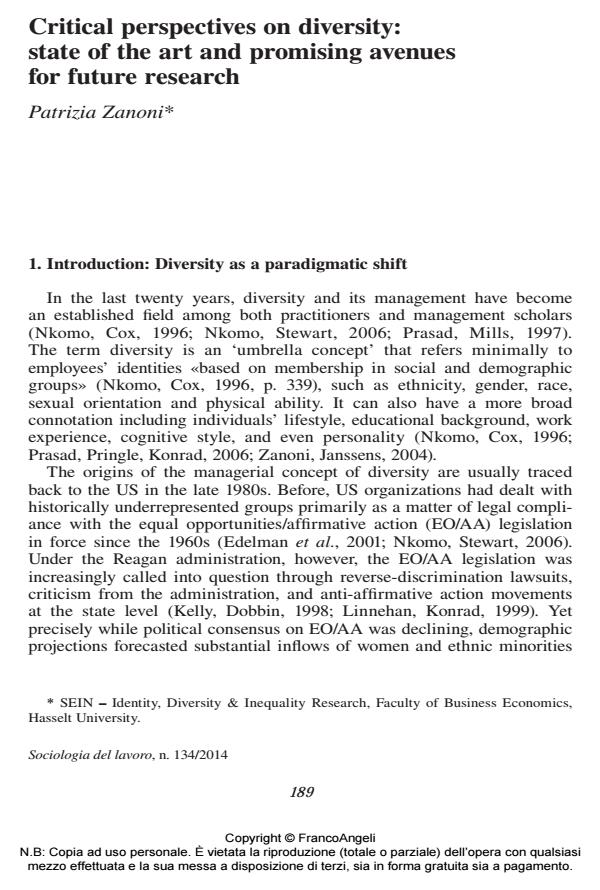Critical perspectives on diversity: state of the art and promising avenues for future research
Titolo Rivista SOCIOLOGIA DEL LAVORO
Autori/Curatori Patrizia Zanoni
Anno di pubblicazione 2014 Fascicolo 2014/134
Lingua Inglese Numero pagine 15 P. 189-203 Dimensione file 111 KB
DOI 10.3280/SL2014-134012
Il DOI è il codice a barre della proprietà intellettuale: per saperne di più
clicca qui
Qui sotto puoi vedere in anteprima la prima pagina di questo articolo.
Se questo articolo ti interessa, lo puoi acquistare (e scaricare in formato pdf) seguendo le facili indicazioni per acquistare il download credit. Acquista Download Credits per scaricare questo Articolo in formato PDF

FrancoAngeli è membro della Publishers International Linking Association, Inc (PILA)associazione indipendente e non profit per facilitare (attraverso i servizi tecnologici implementati da CrossRef.org) l’accesso degli studiosi ai contenuti digitali nelle pubblicazioni professionali e scientifiche
This paper makes a state of the art of the international critically oriented scientific research on diversity, a concept that has increasingly come to refer to sociodemographic identities including, among others, gender, ethnicity, age, sexual orientation, and disability in work settings. While theoretically multifarious, critical approaches to diversity share a focus on the interlocking of socio-demographic identities with power dynamics. Such focus distinguishes them markedly from mainstream approaches aiming at understanding the dynamics of diversity in order to deploy it optimally to achieve organizational goals. After a brief discussion of the specificity of the notion of diversity, the author elaborates on the key theoretical tenets of critical perspectives on diversity and themes that are foundational of this tradition of research. She then identifies four avenues for future critically oriented diversity research starting from the main current debates in the field.
L’articolo presenta lo stato dell’arte della ricerca internazionale di taglio critico sulla diversità. Questo concetto è oggi ampiamente utilizzato per denominare collettivamente le identità sociodemografiche quali il genere, l’etnia, l’età, orientamento sessuale e l’handicap nei luoghi di lavoro. Nonostante gli approcci critici alla diversità abbiano le loro radici in varie tradizioni teoriche, ciò che li accomuna è un interesse per il nesso tra le identità sociodemografiche e le dinamiche di potere. Tale interesse li distingue marcatamente dagli approcci manageriali che sono piuttosto volti a capire le dinamiche della diversità allo scopo di utilizzarla in modo ottimale per il raggiungimento degli obiettivi dell’organizzazione. Dopo aver brevemente discusso la specificità della nozione di diversità, l’autrice delinea i fondamenti teorici principali del filone critico della ricerca su questo tema. Successivamente vengono identificate quattro piste di ricerca ad orientamento critico a partire dai principali aspetti del dibattito odierno. Parole chiave: diversità, diversity management, teoria critica, potere, disuguaglianza, post-strutturalismo
Parole chiave:Diversity, diversity management, critical theory, power, inequality, post-structuralism
Patrizia Zanoni, Critical perspectives on diversity: state of the art and promising avenues for future research in "SOCIOLOGIA DEL LAVORO " 134/2014, pp 189-203, DOI: 10.3280/SL2014-134012